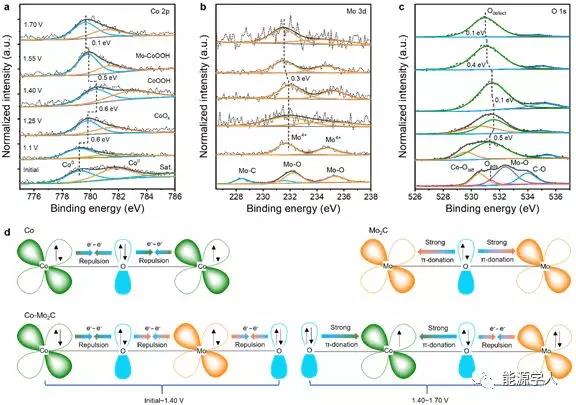
hotline:
17715390137
Tel/Wechat:
18101240246 (Technology)
0512-68565571
Email:mxenes@163.com (Sales Engineer)bkxc.bonnie@gmail.com
Scan the code to follow or search the official account on WeChat:
2D Materials Fronrier After paying attention,
click on the lower right corner to contact us,
Enter enterprise WeChat.
Professional Services Online

The development of high-performance oxygen evolution reaction (OER) catalysts is the key to promoting sustainable energy technologies such as hydrogen production from water decomposition, metal-air batteries, and CO 2 conversion, due to their more complex and slow kinetics. In order to be able to rationally design high-performance OER catalysts, it is extremely important to identify real and effective catalytically active species. Due to its excellent catalytic activity, stability and low cost, Co metal and its compounds have proven to be an ideal OER precatalyst. Recently, a large number of studies have shown that introducing another phase to form Co-X (X is a sulfide, phosphide, carbide, etc.) heterostructure or mixture with Co can significantly improve its OER performance. However, revealing the actual catalytically active substances and species has received very little attention, which has hindered the research and development of such catalysts.
Recently, Dr. Kou Zongkui, a team of Professor John Wang of the National University of Singapore, and Associate Professor Gao Xiaorui (visiting scholar of John Wang group) of Changshu Institute of Technology, and Professor Zheng Lirong of the Beijing Institute of High Energy Physics of the Chinese Academy of Sciences conducted systematic research on STEM and XPS in situ through in-situ Raman, ex-situ The phase transition and surface reconstruction of the Co-Mo 2 C heterojunction during OER revealed that Co quickly and thoroughly transformed into a CoOOH layered structure during the electrocatalytic OER reaction, and Mo was rapidly oxidized and enriched on the surface of CoOOH. Therefore, the OER active material is CoOOH doped on the Mo surface, and Mo and Co interact with each other by bridging O, thereby improving OER catalytic performance. This discovery identified sources of catalytic activity for Co-based heterostructures and provided theoretical support for the rational design of Co-based heterojunction precatalysts. This result was recently published in full text in ACS Catalysis, a top international journal of catalysis. The paper was also obtained by the electron microscopy of Professor He Jiaqing and Yu Yong (co-first author) of Southern University of Science and Technology, and Stephen J. Pennycook of National University of Singapore. stand by. Simon Simon, PhD student at the National University of Singapore, co-first author of the article, provided the in situ Raman test.
【core content】
Figure 1 shows the phase and interface characterization of the Co-Mo 2 C heterostructure. The researchers found that the Co and Mo 2 C phases can form a Mo-Co interface along the [10-1] crystal orientation. Electrochemical characterization found that the intrinsic OER activity of the heterostructure was significantly better than that of Co and Mo2C single crystals with similar nanostructures (Figure 2). Further testing of the products after long OER cycles revealed that the Co-Mo 2 C heterojunction was transformed into Mo-doped ՜ γ-phase CoOOH (Figure 3). In addition, in combination with in situ Raman and ex situ STEM, the researchers confirmed that the Co phase to CoOOH and Mo surface doping are potential-dependent and successive (Figure 4). Ex situ XPS further indicates that Mo can transfer electrons to the Co site through bridged O, thereby improving the catalytic performance of the Co site, and the oxygen defect formed in situ may be another catalytically active site (Figure 5).

Figure 1 Co-Mo 2 C heterojunction precatalyst phase and structure characterization.

Figure 2 Electrocatalytic OER performance test.

Figure 3 Product phase and structure characterization after OER long cycle.

Figure 4 Phase transformation and surface reconstruction during OER in situ Raman and ex-situ STEM studies.

Figure 5 Ex-situ XPS characterization studies of catalyst surface electronic interactions, revealing sources of catalytic activity.
Zongkui Kou, Yong Yu, Ximeng Liu, Xiaorui Gao *, Lirong Zheng *, Haiyuan Zou, Yajun Pang, Zhongyang Wang, Zhenghui Pan, Jiaqing He, Stephen J. Pennycook, John Wang *. Potential-dependent Phase Transition and Mo-enriching Surface Reconstruction of γ-CoOOH in Heterostructured Co-Mo2C Precatalyst Enable Water Oxidation. ACS Catal. 2020, DOI:10.1021 / acscatal.0c00340 .
Source: Energy Scholar

| Reminder: Beijing Beike New Material Technology Co., Ltd. supplies products only for scientific research, not for humans |
| All rights reserved © 2019 beijing beike new material Technology Co., Ltd 京ICP备16054715-2号 |